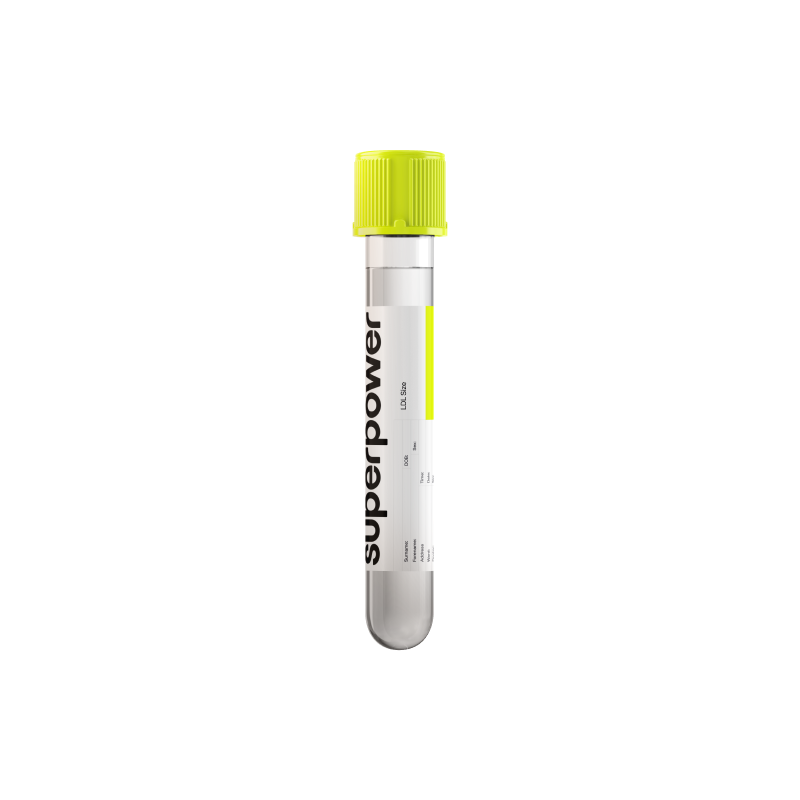LDL Size testing shows whether your particles are predominantly small and dense or larger and buoyant. Small, dense LDL particles are more atherogenic and strongly linked with insulin resistance, metabolic syndrome, and type 2 diabetes.
Larger LDL particles tend to be less risky, but overall risk depends on particle number too. This test adds clarity beyond LDL-C and ApoB, helping you tailor nutrition, exercise, and treatment decisions.
Key Benefits
- Spot your LDL particle size and related heart risk from small, dense particles.
- Flag hidden risk even when LDL cholesterol seems normal or well controlled.
- Explain metabolic health by linking small LDL with high triglycerides and low HDL.
- Guide lifestyle changes to shift LDL larger: lose weight, cut refined carbs, exercise.
- Guide therapy discussions when small LDL predominates alongside high triglycerides or insulin resistance.
- Clarify residual risk on statins by detecting persistent small, dense particles.
- Track your progress as particle size shifts with sustained diet, activity, or medications.
- Best interpreted with triglycerides, HDL-C, apoB or LDL-P, and overall risk.
What is LDL Size?
LDL Size describes how large or small the low‑density lipoprotein particles are in your bloodstream. LDL particles are tiny, cholesterol‑carrying spheres that originate from very‑low‑density lipoprotein (VLDL) made by the liver. As VLDL offloads triglycerides in the circulation, it becomes intermediate‑density lipoprotein (IDL) and then LDL. Each LDL particle contains one apolipoprotein B‑100 (apoB‑100), a core of cholesteryl esters with some triglyceride, and a surface of phospholipids and free cholesterol. Larger LDLs are more buoyant and carry more cholesteryl ester; smaller LDLs are denser with a higher protein‑to‑lipid ratio.
What it reflects: LDL Size captures how LDL has been remodeled during transport—how much triglyceride was exchanged (cholesteryl ester transfer protein, CETP) and trimmed (hepatic lipase), and how much cholesterol the particle now packs. Size influences LDL’s behavior: its cholesterol cargo per particle, how it engages the LDL receptor on cells, and how long it circulates. In short, LDL Size offers a window into the body’s cholesterol delivery system (apoB‑containing lipoprotein metabolism), reflecting the balance between cholesterol transport to tissues and the metabolic processing that shapes LDL particles along the way.
Why is LDL Size important?
LDL size describes how large or small your LDL particles are—the “packaging” that carries cholesterol through your blood. Particle size changes how LDL moves, how long it circulates, and how easily it slips into artery walls and reacts with inflammation and sugars. It links the liver, insulin signaling, and vascular biology into one risk signal.
Most labs classify LDL size into larger, buoyant particles (often called pattern A) and smaller, denser particles (pattern B). As a rule, values toward the higher end (larger) are considered more favorable, though overall risk still depends on particle number (apoB) and LDL cholesterol.
When the reported size is on the smaller side, it usually reflects insulin resistance physiology: the liver overproduces triglyceride‑rich VLDL, lipid exchange reshapes LDL, and hepatic lipase trims them into small, dense particles. These linger longer in blood, penetrate the arterial wall more readily, bind vessel proteoglycans, and oxidize or glycate easily—fueling atherosclerosis. People often show the metabolic cluster of high triglycerides, low HDL, abdominal adiposity, and fatty liver; women with PCOS and teens with obesity commonly show this pattern. Symptoms are silent until vascular disease appears.
When size skews larger, LDL is typically cleared more efficiently and is less oxidation‑prone. This often travels with lower triglycerides and higher HDL. However, if apoB or LDL‑C is high—such as in familial hypercholesterolemia—risk remains elevated despite larger size. Premenopausal women tend to have larger LDL; size can shift smaller after menopause and late in pregnancy.
Big picture: LDL size is a modifier of risk that mirrors triglycerides, HDL, insulin sensitivity, and liver lipoprotein output. Interpreted alongside apoB or LDL particle number, non‑HDL cholesterol, lipoprotein(a), and inflammation markers, it refines long‑term cardiovascular risk.
What Insights Will I Get?
LDL Size measures the average diameter of LDL particles and reflects how your body remodels cholesterol carriers as it moves energy and lipids. Smaller particles penetrate arterial walls more easily, linger longer, and oxidize, so size links metabolic regulation (insulin action, triglyceride handling) with vascular, cardiac, and brain health.
Low values usually reflect a predominance of small, dense LDL (Pattern B). This pattern arises when the liver makes more triglyceride‑rich VLDL in insulin resistance; CETP transfers triglyceride into LDL, then hepatic lipase trims it to smaller particles. It often travels with higher triglycerides, lower HDL, fatty liver biology, and higher inflammatory tone, and increases arterial retention per particle. Men and postmenopausal women more often show smaller LDL than premenopausal women.
Being in range suggests efficient lipid remodeling, adequate insulin sensitivity, and fewer small, dense particles. LDL is cleared more predictably and per‑particle risk is lower. For most labs, optimal tends to sit toward the larger end of the reference interval, but overall particle number (ApoB or LDL‑P) remains the dominant risk signal.
High values usually reflect predominance of large, buoyant LDL (Pattern A). This often accompanies lower triglycerides and higher HDL and indicates less CETP‑driven remodeling. Per particle, atherogenicity is lower, but risk is not negated if ApoB or LDL‑C is elevated. Very large LDL can appear in genetic or endocrine hypercholesterolemia, where particles are cholesterol‑rich and numerous.
Notes: Method matters (NMR, ion mobility, gel) and cutoffs differ. Size shifts with fasting status, triglycerides, acute illness, and hormones/medications (estrogens, androgens). Pregnancy and adolescence can transiently enlarge LDL. Interpret alongside ApoB, triglycerides, HDL‑C, and inflammation markers.



.svg)



.png)
.png)
.png)
.png)








